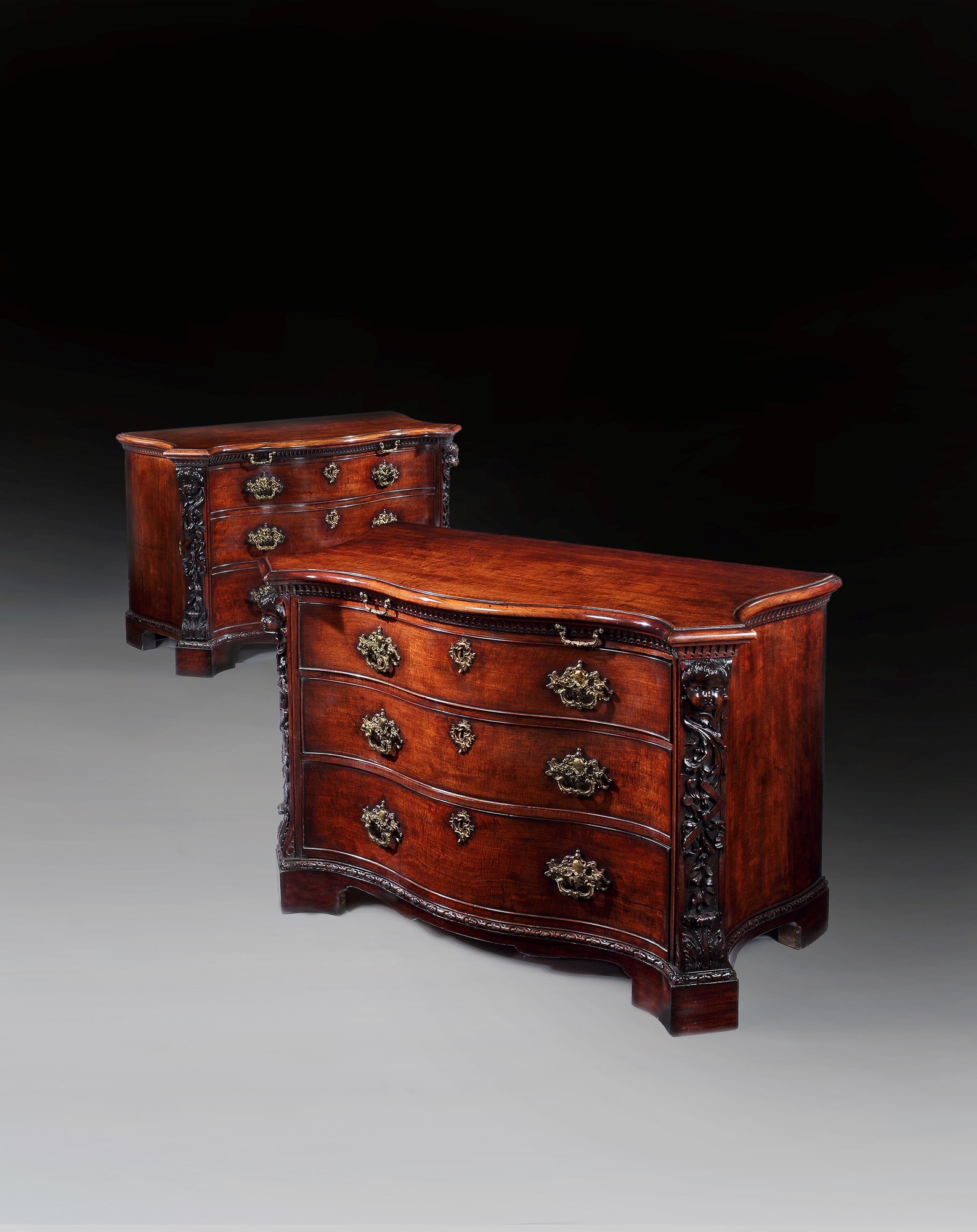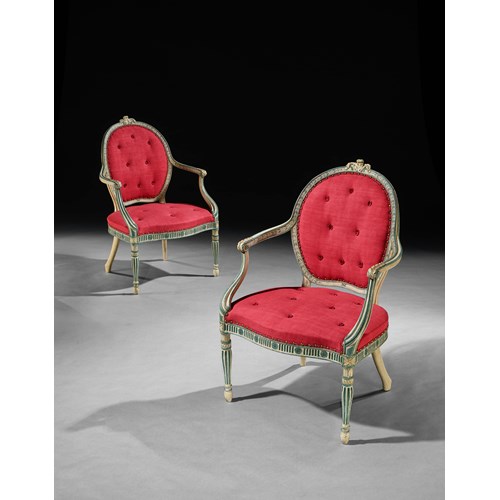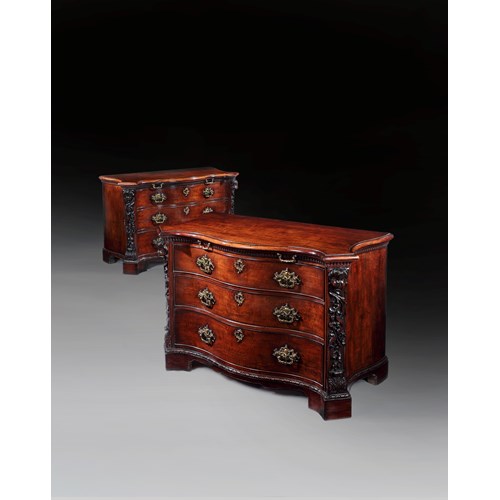Marketplace
A highly important pair of serpentine fronted mahogany commodes
A highly important pair of serpentine fronted mahogany commodes
Date circa 1740
Period George II Period
Origin English
Medium Mahogany
Dimension 85 x 122 x 61.5 cm (33¹/₂ x 48 x 24¹/₄ inches)
Commode one
The boldly shaped serpentine top veneered in finely figured fiddleback mahogany with a moulded edge over a pull out slide with fluted moulding and elaborate cast bronze handles. The top drawer fitted with a writing slide lined with leather opening to reveal compartments and pen trays in solid padouk. The drawers with elaborate cast bronze handles and escutcheons. The front canted corners finely carved with winged putti, foliage, set square and dividers tied with ribbons over an acanthus leaf.
The lower moulding carved with flower and dart over shaped bracket feet.
Commode two
The boldly shaped serpentine top veneered in the same finely figured fiddle-back mahogany with a moulded edge over a pull out slide with fluted moulding and cast bronze handles.
The front configured as three blind drawers with elaborate cast bronze handles and escutcheons. The serpentine sides with doors opening to cupboards fitted with shelves to both sides.
The front canted corners with applied carving of winged putti, finely detailed foliage, set square and dividers tied with ribbons over an acanthus bracket. The lower moulding carved with flower and dart over shaped bracket feet.
This outstanding pair of commodes, belong to a group of related Baroque examples, ascribed to the workshops of either William Vile, or William Hallett with the carving attributed to John Boson. Many of the designs of this group include well-modelled cherub or putti heads. The design and technique of carving was clearly inspired by the work of Grinling Gibbons (1648-1721). An almost identical treatment can be seen in his work at Trinity College Chapel in Oxford.
The quality of the cabinetmaking throughout and especially the carving of the dense West Indian mahogany is of the highest quality and the choice of densely figured fiddle back mahogany veneers used throughout is exceptional. Interestingly, these two commodes although different in their form, one being conceived as a chest of drawers and the other as a side opening cupboard, were made together as a pair. The veneers used on each of the respective drawers were kept in sequence, resulting in the timber of both commodes having an identical figuring to the timber of the drawers.
William Vile of 1700-1767 of 72 St. Martins Lane, London was apprentice to William Hallett and was originally a journeyman in Hallett’s employment. He set up a workshop next door to Hallett and the two cabinetmakers evidentially worked closely together. Many payments were made to Hallett by Vile and are detailed in his accounts.
William Hallett was born in 1707 and died in 1767. He and William Vile were both born in Somerset, which might account for their close working relationship.
A Pair of commodes clearly by the same maker but less elaborate in form were in the Moller Collection from Thorncombe Park, Surrey, sold by Sothebys in 1993, lot 85.
Provenance
One commode was in The Mulliner Collection, illustrated in ‘The Decorative Arts in England 1660-1780,’ by H.H Mulliner, Fig 16. Interestingly, the text states:
‘designed specifically for a great house in Yorkshire, from whence it came to this collection. The original owner was a nobleman interested in architecture and the set square and compasses in the ornament symbolise his taste.’
Mrs Nickols, 2 Seamore Place, Mayfair,
Gifted in her will to her granddaughter circa 1960
Mrs Nickols whose house overlooked Park Lane was remembered as a woman who frequented the auction rooms and galleries of Mayfair and took a table at the Ritz everyday.
One commode fitted as a chest of three long drawers with a brushing slide. The other conceived as a cupboard with side opening doors.
Attributed to the workshop of William vile or William Hallett the carving possibly by John Boson.
REF952
One commode fitted as a chest of three long drawers with a brushing slide. The other conceived as a cupboard with side opening doors.
The boldly shaped serpentine top veneered in finely figured fiddleback mahogany with a moulded edge over a pull out slide with fluted moulding and elaborate cast bronze handles. The top drawer fitted with a writing slide lined with leather opening to reveal compartments and pen trays in solid padouk. The drawers with elaborate cast bronze handles and escutcheons. The front canted corners finely carved with winged putti, foliage, set square and dividers tied with ribbons over an acanthus leaf.
The lower moulding carved with flower and dart over shaped bracket feet.
Commode two
The boldly shaped serpentine top veneered in the same finely figured fiddle-back mahogany with a moulded edge over a pull out slide with fluted moulding and cast bronze handles.
The front configured as three blind drawers with elaborate cast bronze handles and escutcheons. The serpentine sides with doors opening to cupboards fitted with shelves to both sides.
The front canted corners with applied carving of winged putti, finely detailed foliage, set square and dividers tied with ribbons over an acanthus bracket. The lower moulding carved with flower and dart over shaped bracket feet.
This outstanding pair of commodes, belong to a group of related Baroque examples, ascribed to the workshops of either William Vile, or William Hallett with the carving attributed to John Boson. Many of the designs of this group include well-modelled cherub or putti heads. The design and technique of carving was clearly inspired by the work of Grinling Gibbons (1648-1721). An almost identical treatment can be seen in his work at Trinity College Chapel in Oxford.
The quality of the cabinetmaking throughout and especially the carving of the dense West Indian mahogany is of the highest quality and the choice of densely figured fiddle back mahogany veneers used throughout is exceptional. Interestingly, these two commodes although different in their form, one being conceived as a chest of drawers and the other as a side opening cupboard, were made together as a pair. The veneers used on each of the respective drawers were kept in sequence, resulting in the timber of both commodes having an identical figuring to the timber of the drawers.
William Vile of 1700-1767 of 72 St. Martins Lane, London was apprentice to William Hallett and was originally a journeyman in Hallett’s employment. He set up a workshop next door to Hallett and the two cabinetmakers evidentially worked closely together. Many payments were made to Hallett by Vile and are detailed in his accounts.
William Hallett was born in 1707 and died in 1767. He and William Vile were both born in Somerset, which might account for their close working relationship.
A Pair of commodes clearly by the same maker but less elaborate in form were in the Moller Collection from Thorncombe Park, Surrey, sold by Sothebys in 1993, lot 85.
Provenance
One commode was in The Mulliner Collection, illustrated in ‘The Decorative Arts in England 1660-1780,’ by H.H Mulliner, Fig 16. Interestingly, the text states:
‘designed specifically for a great house in Yorkshire, from whence it came to this collection. The original owner was a nobleman interested in architecture and the set square and compasses in the ornament symbolise his taste.’
Mrs Nickols, 2 Seamore Place, Mayfair,
Gifted in her will to her granddaughter circa 1960
Mrs Nickols whose house overlooked Park Lane was remembered as a woman who frequented the auction rooms and galleries of Mayfair and took a table at the Ritz everyday.
One commode fitted as a chest of three long drawers with a brushing slide. The other conceived as a cupboard with side opening doors.
Attributed to the workshop of William vile or William Hallett the carving possibly by John Boson.
REF952
One commode fitted as a chest of three long drawers with a brushing slide. The other conceived as a cupboard with side opening doors.
Date: circa 1740
Period: George II Period
Origin: English
Medium: Mahogany
Dimension: 85 x 122 x 61.5 cm (33¹/₂ x 48 x 24¹/₄ inches)
More artworks from the Gallery









